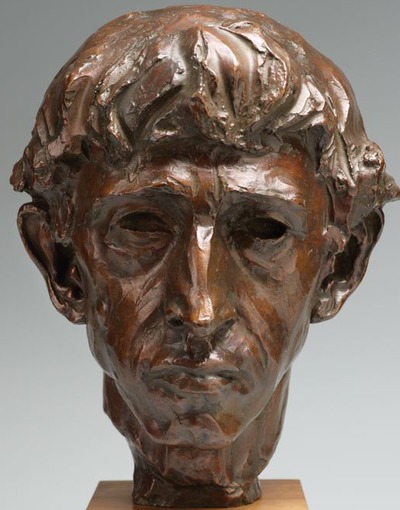 An important survey of the work of Gaston Lachaise, one of the leading sculptors working in the U.S. in the early part of the 20th century, is now on exhibit at the Bruce Museum in Greenwich.
An important survey of the work of Gaston Lachaise, one of the leading sculptors working in the U.S. in the early part of the 20th century, is now on exhibit at the Bruce Museum in Greenwich.
By Arthur Stampleman
 An important survey of the work of Gaston Lachaise, one of the leading sculptors working in the U.S. in the early part of the 20th century, is now on exhibit at the Bruce Museum in Greenwich.
An important survey of the work of Gaston Lachaise, one of the leading sculptors working in the U.S. in the early part of the 20th century, is now on exhibit at the Bruce Museum in Greenwich.
“Face & Figure: The Sculpture of Gaston Lachaise” includes key examples of the artist’s work focusing on the human body, many on loan from leading museums, private collections, and the Lachaise Foundation. Among them are three monumental sculptures, a dozen portrait busts, bas-reliefs, and six drawings.
Called by ARTnews the “greatest American sculptor of his time,” Lachaise was a major figure in the transition from “statues” to “sculpture” in the early part of the last century. At a time when sculptors here focused on statues depicting historical events and important leaders, Lachaise was part of the movement to introduce modernist elements in sculpture — everyday situations, some figures without regard to accurate representation, and a focus on form and emotion, though not abstraction or cubism.
Born in Paris in 1882, the son of a cabinetmaker, he studied at Academie Nationale des Beaux-Arts, where he received formal classical training. He exhibited annually at the Salon and apprenticed himself to the decorative artist René Lalique, an experience that added an organic, art nouveau element to his approach. But at a time when Paris was the center of the art world and American artists moved there, Lachaise met an American who became the love of his life and he traveled in the opposite direction.
In 1902, he met and fell in love with Isabel Dutaud Nagle, an American woman of French-Canadian descent who was in Paris. In December 1905, at the age of 23, Lachaise set sail for Boston never to return to his native land. He proceeded to devote his life to her. “You are the Goddess I am seeking to express in all things,” he wrote her.
 Lachaise’s oeuvre is dominated by Nagle; his most compelling works are sculpted elegies to her body. She is evident in almost all of the artist’s nude female figures, not only the monumental works but also statuettes, reliefs, and even drawings: large trunk and belly; ample breasts and wide hips; rather flat, high buttocks; long, slender legs; and extremely pretty feet.
Lachaise’s oeuvre is dominated by Nagle; his most compelling works are sculpted elegies to her body. She is evident in almost all of the artist’s nude female figures, not only the monumental works but also statuettes, reliefs, and even drawings: large trunk and belly; ample breasts and wide hips; rather flat, high buttocks; long, slender legs; and extremely pretty feet.
Three portrayals of his muse are on view, including
 Portraits were another important aspect of Lachaise’s work. The show includes realistic life-size busts of several important art figures of the period — E.E. Cummings, Georgia O’Keeffe. Alfred Stieglitz, John Marin, George L.K. Morris, and Lincoln Kirstein, all of which are said to capture the personalities of these individuals. There are also three sculptures of nude male figures, including one of the two bronzes of the nude portrait of Kirsten, which the Bruce acquired a few years ago. That acquisition prompted the idea for this exhibition, which is curated by Ken Silver, NYU Professor of Modern Art and Bruce Museum Adjunct Curator.
Portraits were another important aspect of Lachaise’s work. The show includes realistic life-size busts of several important art figures of the period — E.E. Cummings, Georgia O’Keeffe. Alfred Stieglitz, John Marin, George L.K. Morris, and Lincoln Kirstein, all of which are said to capture the personalities of these individuals. There are also three sculptures of nude male figures, including one of the two bronzes of the nude portrait of Kirsten, which the Bruce acquired a few years ago. That acquisition prompted the idea for this exhibition, which is curated by Ken Silver, NYU Professor of Modern Art and Bruce Museum Adjunct Curator.
Most of the sculptures displayed are bronze, but there are four carved works in alabaster or marble. Lachaise was equally comfortable working in clay to form bronzes, or carving stone (his father was a carver). His surface is generally very smooth (like Maillol, unlike Rodin), but the surface of some of the portraits, especially that of Marin, captures their features and expressions.
Lachaise and Nagle were married in 1917 in New York. He had a successful career and was honored with the first retrospective given to a living artist at the Museum of Modern Art in 1935. Sadly, he died the same year, at the age of 53.
“Face & Figure: The Sculpture of Gaston Lachaise” is at the Bruce Museum until January 6. Hours are 10-5 Tuesday-Saturday and 1-5 on Sunday. Docent tours are offered most Fridays at 12:30. For information, call 203-869-0376 or visit www.brucemuseum.org.















